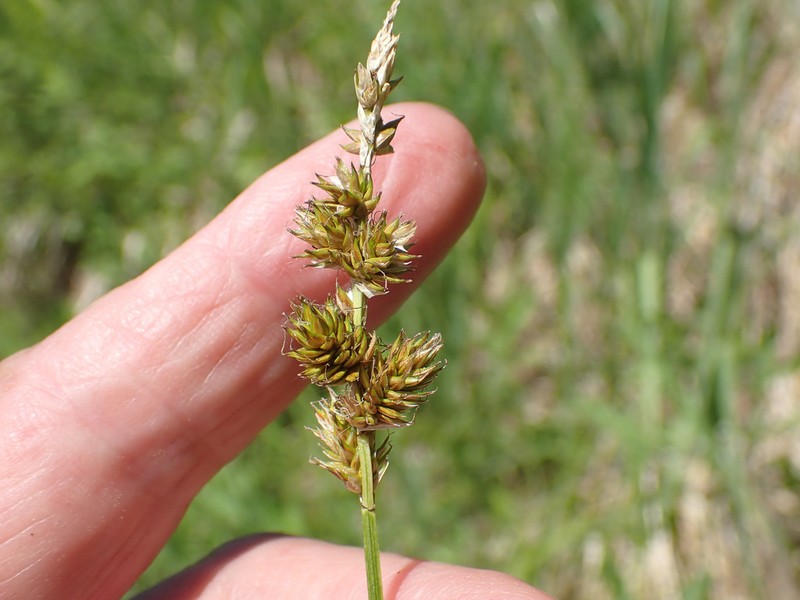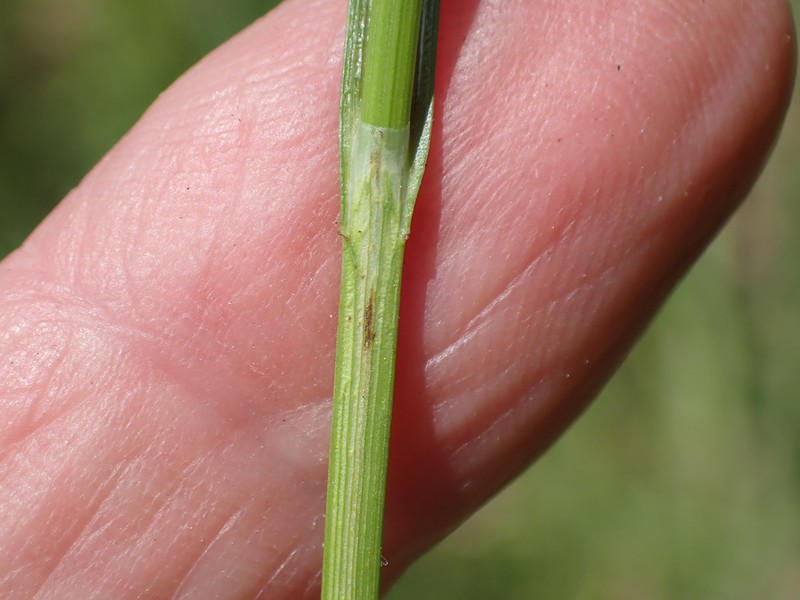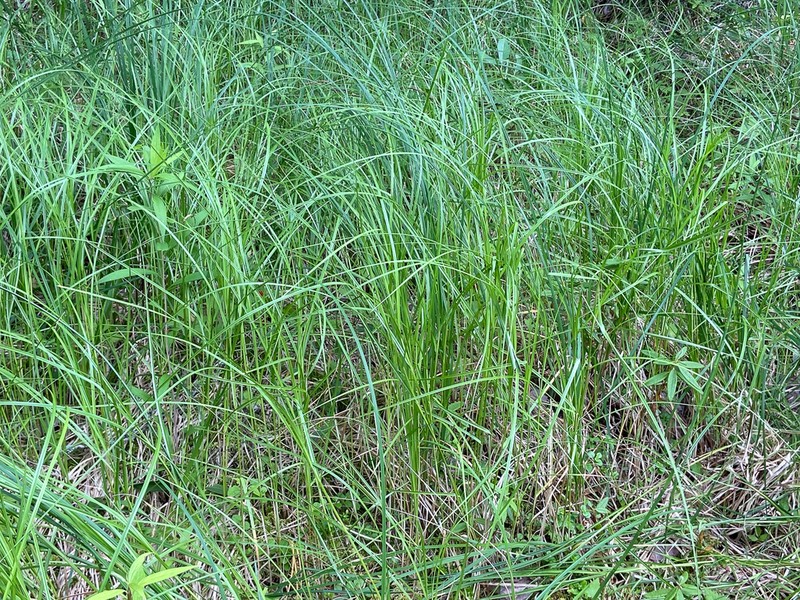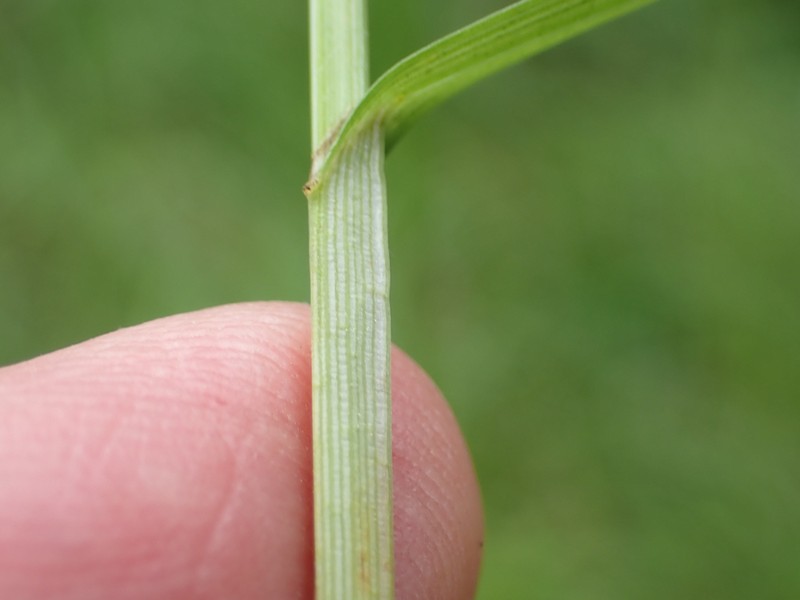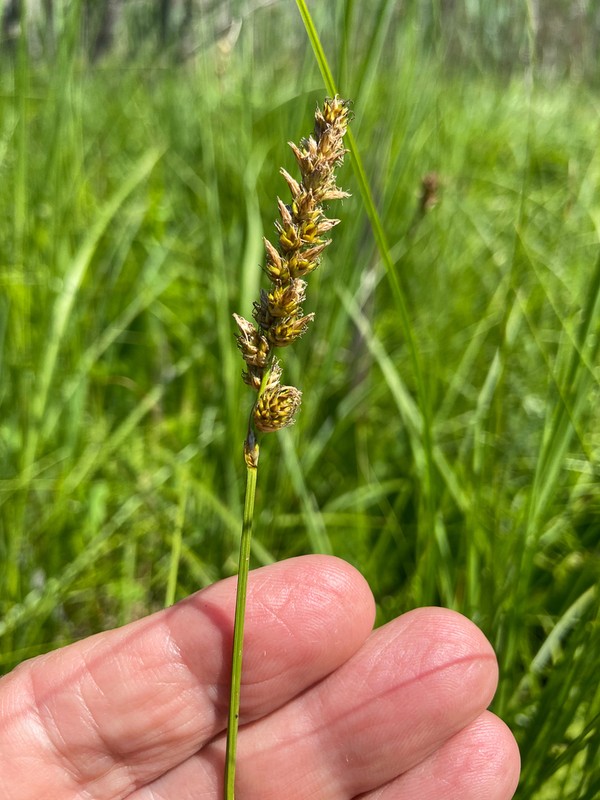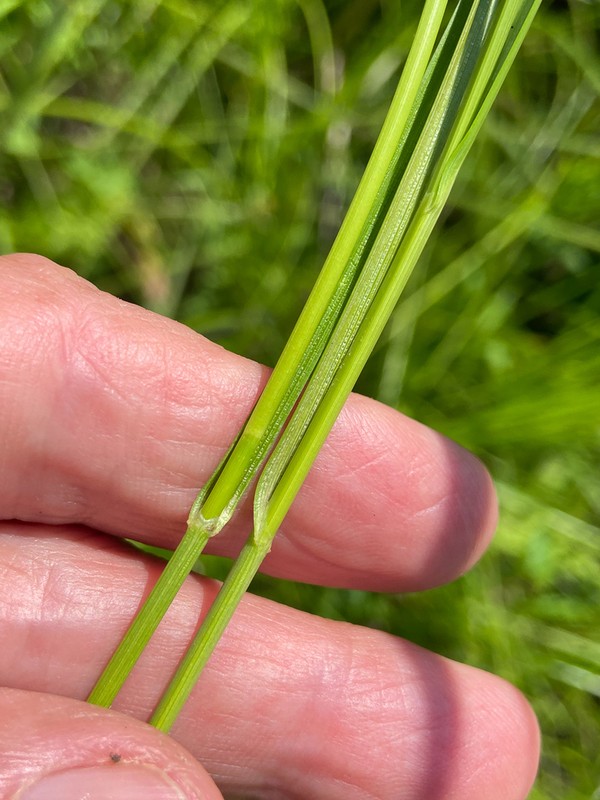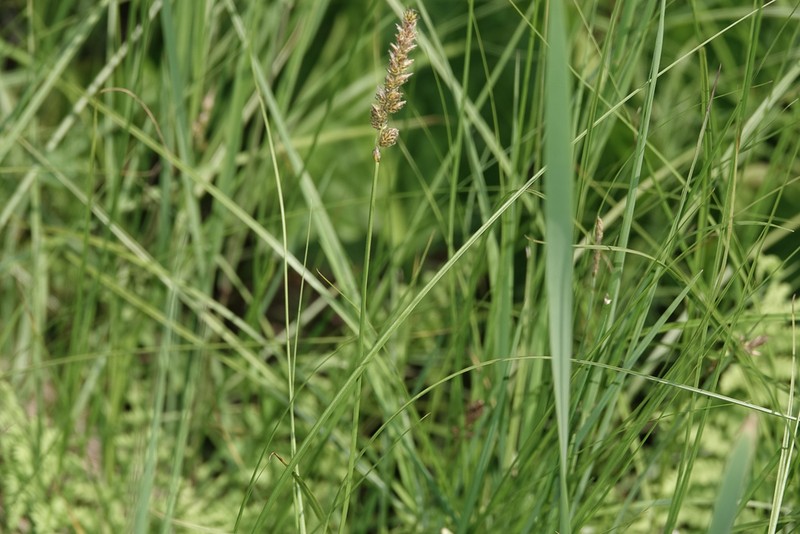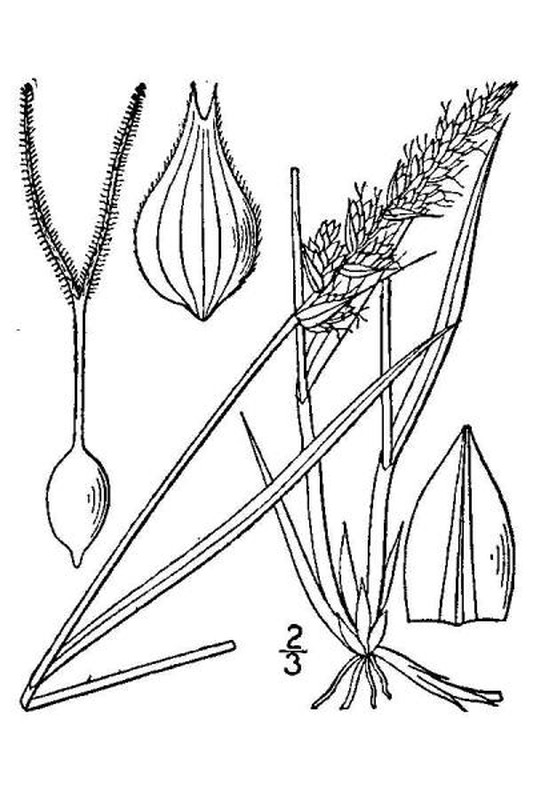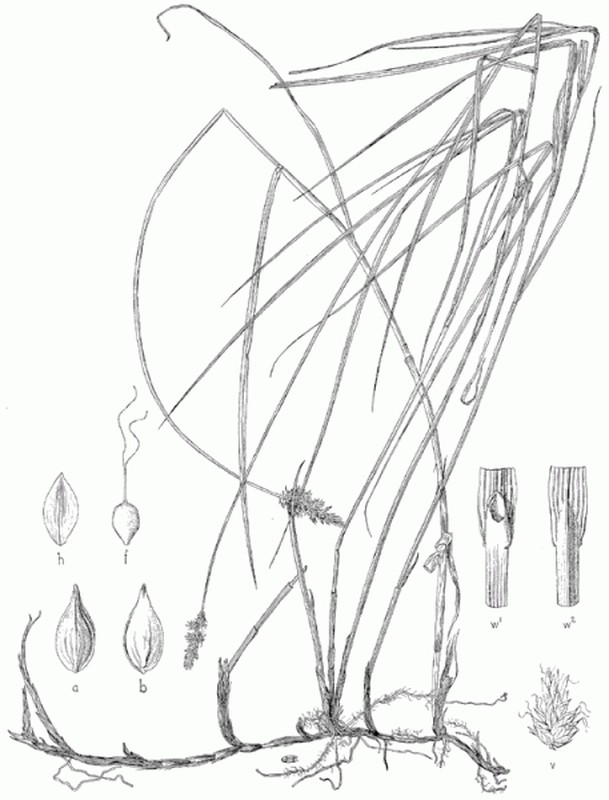Sartwell's Sedge
Carex sartwellii Dewey
- Class
- Monocotyledoneae (Monocots)
- Family
- Cyperaceae (Sedge Family)
- State Protection
- Endangered
Listed as Endangered by New York State: in imminent danger of extirpation in New York. For animals, taking, importation, transportation, or possession is prohibited, except under license or permit. For plants, removal or damage without the consent of the landowner is prohibited.
- Federal Protection
- Not Listed
- State Conservation Status Rank
- S1S2
Critically Imperiled or Imperiled in New York - Especially or very vulnerable to disappearing from New York due to rarity or other factors; typically 20 or fewer populations or locations in New York, very few individuals, very restricted range, few remaining acres (or miles of stream), and/or steep declines. More information is needed to assign either S1 or S2.
- Global Conservation Status Rank
- G5
Secure globally - Common in the world; widespread and abundant (but may be rare in some parts of its range).
Summary
Did you know?
The specific epithet sartwellii is named in honor of Henry Parker Sartwell, 1792-1867, who discovered this species (Fernald 1970). Sartwell was from Penn Yan, New York and was a prolific collector (Wiegand and Eames 1926). Many of Sartwell's specimens have no locality information beyond "Penn Yan". Unfortunately, this locality information appears to indicate simply where he lived and not where the specimens were actually collected.
State Ranking Justification
There are three known populations and fewer than ten historical populations. This is a plant of fens and calcareous wetlands, a limited and threatened habitat. Some of the historical populations apparently still have appropriate habitat and should be surveyed. Some of the populations may be threatened by various invasive species, particularly Phragmites. A few sites have been lost to muck farming and other types of development.
Short-term Trends
There are four populations that have been seen in recent year but trends in population size is unclear. Most of these extant populations appear to be healthy and robust and there is no indication that there is a decline. Therefore, short-term trends are not clear but may indicate that this species is stable in New York.
Long-term Trends
There are two populations that are believed to be extirpated. One as a result of agriculture and the other as a result of urban development. Three populations have been known for about 90 years but clear trends in these populations are unknown. These three populations currently appear to be healthy and may be stable. One population was first discovered in 1990. This population was probably over looked in the past. Approximately, an additional seven populations are only known from historical records. It is unknown if these populations are still extant. Overall, long term trends appear to at least indicate a moderate decline in populations.
Conservation and Management
Threats
One population is potentially threatened by an adjacent gravel mine and encroaching residential development. Another populations occurs adjacent to a railroad line. There is the potential that herbicide spraying to keep the railroad grade open could negatively impact this population. Changes in hydrology including flooding could also negatively impact populations.
Conservation Strategies and Management Practices
An attempt should be made to gain protection of the one population that is adjacent to a gravel mine and encroaching residential development. Herbicide spraying should be prevented adjacent to the one population that is near a railroad. The hydrological regimes at all populations should be monitored and maintained where necessary.
Research Needs
All historical populations should be surveyed. Where possible, accurate population size in area should be measured.
Habitat
Habitat
Carex sartwellii occurs in rich fens, sedge meadows, and rich swamps sometimes adjacent to ponds. It occurs in areas without any woody plant canopy to partly shaded wet forested habitat. All sites in New York are strongly calcareous and wet (New York Natural Heritage Program 2006). Fens, wet prairies, sedge meadows, marshes, wet, open thickets, open swamps, stream, pond, and lakeshores, ditches, often in shallow water (Reznicek and Catling 2002). Wet open sandy or mucky ground, often calcareous, including marshes and meadows, lake shores, and thicket borders on dolomite pavement (Voss 1972). Calcareous bogs, marshes, and swales (Fernald 1970).
Associated Ecological Communities
- Marl fen*
(guide)
A wetland that occurs on a bed of marl. Marl is a whitish substance that is deposited from water that has a lot of calcium dissolved in it. The whitish substance is calcium carbonate, people used to harvest marl to lime agricultural fields. The marl substrate is always saturated, may be flooded, and has a very high pH, generally greater than 7.5. The main source of water is always groundwater. The plants are often sparse and stunted. Marl fens may occur as small patches within a rich graminoid fen.
- Northern white cedar swamp*
(guide)
A swamp that occurs on organic soils in cool, poorly drained depressions in central and northern New York, and along lakes and streams in the northern half of the state. These swamps are often spring-fed with continually saturated soils. Soils are often rich in calcium. The characteristic tree is northern white cedar, which makes up more than 30% of the canopy cover.
- Red maple-tamarack peat swamp
(guide)
A swamp that occurs on organic soils (peat or muck) in poorly drained depressions. These swamps are often spring fed or enriched by seepage of mineral-rich groundwater resulting in a stable water table and continually saturated soil. The dominant trees are red maple and tamarack. These species usually form an open canopy (50 to 70% cover) with numerous small openings dominated by shrubs or sedges.
- Rich graminoid fen
(guide)
A wetland of mostly grasses usually fed by water from highly calcareous springs or seepage. These waters have high concentrations of minerals and high pH values, generally from 6.0 to 7.8. Plant remains do not decompose rapidly and these grasses usually grow on older, undecomposed plant parts.
- Rich shrub fen*
(guide)
A wetland with many shrubs that is usually fed by water from springs and seeps. These waters have high concentrations of minerals and high pH values, generally from 6.0 to 7.8. Plant remains in these fens do not decompose rapidly and thus the plants in these fens usually grow on older, undecomposed woody plant parts.
- Rich sloping fen*
(guide)
A small, gently sloping wetland that occurs in a shallow depression on a slope composed of calcareous glacial deposits. Sloping fens are fed by small springs or groundwater seepage. Like other rich fens, their water sources have high concentrations of minerals and high pH values, generally from 6.0 to 7.8. They often have water flowing at the surface in small channels or rivulets.
- Sedge meadow
(guide)
A wet meadow community that has organic soils (muck or fibrous peat). Soils are permanently saturated and seasonally flooded. The dominant herbs must be members of the sedge family, typically of the genus Carex.
* probable association but not confirmed.
Associated Species
- Carex aquatilis (water sedge)
- Carex lasiocarpa
- Carex pellita (woolly sedge)
- Carex sterilis (dioecious sedge)
- Carex stricta (tussock sedge)
- Larix laricina (tamarack)
- Salix candida (sage-leaved willow)
- Salix serissima (autumn willow)
Range
New York State Distribution
Carex sartwellii mostly occurs in north cental New York but ranges west to Buffalo and north to St. Lawrence County. It is at the eastern edge of its range in New York.
Global Distribution
Carex sartwellii occurrs from the Northwest Territories, British Columbia, and Idaho east to Quebec, New York, and Pennsylvania. It is major wetland species in the Midwest and West but is local and uncommon in the east (Reznicek and Catling 2002).
Identification Comments
General Description
Sartwell's sedge is a tall grass-like perennial that grows in large patches. Stems 30-120 cm or slightly taller occur singly along the rhizomes. Leaves occur along these stems and are 2.5-4.6 mm wide. Many of these stems do not develop flowers. At the top 2.5-9.0 cm of some of the stems are flower/fruit clusters (spikes). The spikes are numerous and densely arranged. Each spike is composed of either all male flowers, all female flowers, or have male flowers above and female flowers below. Fruits (perigynia) are 2.5-4.6 mm long (Reznicek and Catling 2002).
Identifying Characteristics
Carex sartwellii is long rhizomatous and colonial. Many of the stems are often vegetative. The vegetative stems are true stems with nodes unlike many other Carex species. Reproductive culms are (30-)40-120 cm tall. Leaf sheaths are green veined and herbaceous on the ventral surface except the apices of the distal sheaths are hyaline and prolonged. The inflorescences are 2.5-7.0(-9.0) cm long and composed of 9-37 densely arranged androgynous or unisexual sessile spikes. Perigynia are (2.5-)2.8-4.1(-4.6) mm long (Reznicek and Catling 2002).
Best Life Stage for Proper Identification
It is easiest to identify C. sartwellii when it has immature to mature fruits but patches can be largely vegetative. It is possible to identify this species vegetatively although reproductive material is helpful.
Similar Species
The closely related C. disticha is a rare introduction in southern Quebec and Ontario. It differs in having larger perigynia (3.8-)4.0-5.5(-6.1) mm long and lower spikes usually much larger than middle spikes versus larger perigynia (2.5-)2.8-4.1(-4.6) mm long and lower spikes only slightly if at all larger than middles spikes in C. sartwellii (Reznicek and Catling 2002). Carex praegracilis has been misidentified as C. sartwellii in Michigan (Voss 1972). It differs in having vegetative stems with leaves clustered at the base of the plant vs. leaves spread along the culms for C. sartwellii (Voss 1972, Reznicek and Catling 2002).
Best Time to See
Carex sartwellii starts to fruit in June and fruits persist until about mid-July. Therefore, the best time to survey for this species is from June to mid-July.
- Fruiting
The time of year you would expect to find Sartwell's Sedge fruiting in New York.
Sartwell's Sedge Images
Taxonomy
Sartwell's Sedge
Carex sartwellii Dewey
- Kingdom Plantae
- Phylum Anthophyta
- Class Monocotyledoneae
(Monocots)
- Order Cyperales
- Family Cyperaceae (Sedge Family)
- Order Cyperales
- Class Monocotyledoneae
(Monocots)
- Phylum Anthophyta
Comments on the Classification
Carex sartwellii is the only North American native member of section Holarrhenae. The Euasian C. disticha, which is the only other member of section Holarrhenae, is a rare introduction in North America (Reznicek and Catling 2002).
Additional Resources
Best Identification Reference
Reznicek, A.A. and P.M. Catling. 2002. Carex Linnaeus sect. Holarrhenae Döll) Pax. Pages 301-302 in Flora of North America Editorial Committee (editors), Flora of North America, North of Mexico, Volume 23, Magnoliophyta: Commelinidae (in part): Cyperaceae. Oxford University Press, New York, NY, USA. 608pp + xxiv.
Other References
Fernald, M.L. 1950. Gray's manual of botany. 8th edition. D. Van Nostrand, New York. 1632 pp.
Gleason, Henry A. and A. Cronquist. 1991. Manual of Vascular Plants of Northeastern United States and Adjacent Canada. The New York Botanical Garden, Bronx, New York. 910 pp.
Holmgren, Noel. 1998. The Illustrated Companion to Gleason and Cronquist's Manual. Illustrations of the Vascular Plants of Northeastern United States and Adjacent Canada. The New York Botanical Garden, Bronx, New York.
New York Natural Heritage Program. 2010. Biotics database. New York Natural Heritage Program. New York State Department of Environmental Conservation. Albany, NY.
New York Natural Heritage Program. 2024. New York Natural Heritage Program Databases. Albany, NY.
Reschke, Carol. 1990. Ecological communities of New York State. New York Natural Heritage Program, New York State Department of Environmental Conservation. Latham, NY. 96 pp. plus xi.
Voss, E.G. 1972. Michigan Flora, Part I. Gymnosperms and Monocots. Cranbrook Institute of Science Bulletin 55 and the University of Michigan Herbarium. Ann Arbor. 488 pp.
Weldy, T. and D. Werier. 2010. New York flora atlas. [S.M. Landry, K.N. Campbell, and L.D. Mabe (original application development), Florida Center for Community Design and Research http://www.fccdr.usf.edu/. University of South Florida http://www.usf.edu/]. New York Flora Association http://newyork.plantatlas.usf.edu/, Albany, New York
Wiegand, K.M. and A.J. Eames. 1926. The flora of the Cayuga Lake Basin, New York. Cornell University, Agricultural Experiment Station, Memoir 92, Ithaca, NY. 491 pp + map.
Links
About This Guide
Information for this guide was last updated on: November 4, 2022
Please cite this page as:
New York Natural Heritage Program. 2024.
Online Conservation Guide for
Carex sartwellii.
Available from: https://guides.nynhp.org/sartwells-sedge/.
Accessed July 26, 2024.
